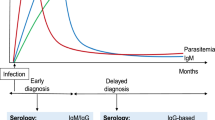Abstract
Leishmania tropica promastigotes are easily attached to and engulfed by C3H peritoneal macrophages in vitro at 37°C. Different sugars at 0.3–0.5 M inhibited in vitro the attachment ofL. tropica promastigotes to C3H peritoneal macrophages with lactose (Gal-β [1→4]Glc) being the most efficient. Inhibition of attachment is also affected by pre-treatment of promastigotes with galactose oxidase. Oligosaccharides extending from promastigote and amastigote cell surfaces contain an important proportion of non-reducing galactose as does the carbohydrate-rich factor (EF) excreted by promastigotes ofL. tropica andL. donovani. This study suggests thatLeishmania, an obligatory intracellular parasite, uses as a means of entering the host cell a cellular mechanism similar to that used in the removal of damaged cells from blood circulation. This mechanism is assumed to take advantage of the exposed sugars, particularly the exposed non-reducing galactose, on the parasite surface during the stage of attachment. Once the parasite is inside the cell, the EF it produces might have a protective function, being inhibitory to some of the host cell lysosomal enzymes.
Similar content being viewed by others
References
Abrahams JC, Zehavi U, Granoth R, Slutzky GM, El-On J, Greenblatt CL (1981) Affinity chromatographic methods for the purification of leishmanial excreted factor. In: Slutzky GM (ed) Biochemistry of parasites. Pergamon, Oxford, New-York, Toronto, Sydney, Paris, Frankfurt, p 171
Ashwell GA, Morell AG (1974) The role of surface carbohydrates in the hepatic recognition and transport of circulating glycoproteins. Adv Enzymol 41:99–128
Bell WC, Levy GN, Williams R, Aminoff D (1977) Effect of galactose oxidase with and without prior sialidase treatment on the viability of erythrocytes in circulation. Proc Natl Acad Sci USA 74:4205–4209
Camargo EP (1964) Growth and differentiation inTrypanosoma cruzi. I. Origin of metacyclic trypanosomes in liquid media. Rev Inst Med Trop São Paulo 6:93–100
Chang KP (1979)Leishmania donovani: promastigote-macrophage surface interaction in vitro. Exp Parasitol 48:175–189
Choy YM, Wong SL, Lee CY (1979) Changes in surface carbohydrates during in vivo aging. Biochem Biophys Res Commun 91:410–415
Clamp JR, Bhatti T, Chambers RE (1971) The determination of carbohydrates in biological materials by gas-liquid chromatography. In: Glick D (ed) Methods of biochemical analysis. Interscience Publishers, New-York, London, Toronto, Vol 19, pp 299–344
Danon D, Marikovsky Y, Skutelsky E (1971) The sequestration of old red cells and extruded erythroid nuclei. In: Ramot B (ed) Red cell structure and metabolism. Academic Press New York, pp 23–38
Dishon T, Slutzky GM, El-On J, Greenblatt CL (1981) Coagglutination and passive haemagglutination in the detection of an excreted immunologically active substance fromLeishmania. Isr J Med Sci 17:245–248
Duorcher JR, Payne RC, Conrad ME (1975) Role of sialic acid in erythrocyte survival. Blood 45:11–20
El-On J, Schnur LF, Greenblatt CL (1979)Leishmania donovani: physicochemical, immunological and biological characterization of excreted factor (EF) from promastigotes. Exp Parasitol 47:254–269
El-On J, Bradley DJ, Freeman JC (1980)Leishmania donovani: Action of excreted factor on hydrolytic enzyme activity of macrophages from mice with genetically different resistance to infection. Exp Parasitol 49: 167–174
El-On J, Slutzky GM, Greenblatt CL, Zehavi U, Abrahams JC (1981) A possible role for leishmanial excreted factor (EF) in the infective process: In: Slutzky GM (ed), Biochemistry of parasites. Pergamon, Oxford, New-York, Toronto, Sydney, Paris, Frankfurt, p. 172
El-On J, Pearlman E, Schnur LF, Greenblatt CL (1983) An in vitro study of the chemotherapeutic activity of rifampicin on leishmanial amastigotes and promastigotes. Isr J Med Sci 19:240–245
Jacobson RL, Slutzky GM, Greenblatt CL, Schnur LF (1982) Surface reaction ofLeishmania. I. Lectin-mediated agglutination. Ann Trop Med Parasitol 76:45–52
Kolb H, Kolb-Bachofen V (1978) Effect of galactose oxidase with and without prior sialidase treatment on the viability of erythrocytes in circulation. Biochem Biophys Res Commun 85:678–683
Kolb H, Kriese A, Kolb-Bachofen V, Kolb HA (1978) Possible mechanism of entrapment of neuraminidase-treated lymphocytes in the liver. Cell Immunol 40:457–462
La Badie JH, Chapman KP, Aronson NN Jr (1975) Glycoprotein catabolism in rat liver: Lysosomal digestion of iodinated asialo-fetuin. Biochemistry 152:271–279
Nagamura Y, Kolb H (1980) Presence of a lectin-like receptor for D-galactose on rat peritoneal macrophages. FEBS Lett 115:59–62
Neufeld EF, Ashwell G (1980) Carbohydrate recognition system for receptor mediated pinocytosis. In: Lennarz WJ (ed), The biochemistry of glycoproteins and proteoglycans. Plenum Press, New York and London, p 241–266
Sarkar M, Liao J, Kabat EA, Tanabe T, Ashwell G (1979) The binding site of rabbit hepatic lectin. J Biol Chem 254:3170–3174
Schnur LF, Zuckerman A, Greenblatt CL (1972) Leishmanial serotypes as distinguished by the gel diffusion of factors excreted in vitro and in vivo. Isr J Med Sci 7:931–942
Stowell CP, Lee YC (1978) The binding of D-glucosyl-neoglycoproteins to the hepatic asialoglycoprotein receptor. J Biol Chem 253:6107–6110
Terao T, Irimura T, Osawa T (1975) Purification and characterization of a haemagglutination fromArachis hypogaea. Hoppe-Seylers Z Physiol Chem 356:1685–1692
Wall DA, Wilson G, Hubbard AL (1980) The galactose-specific recognition system of mammalian liver: the route of ligand internalization in rat hepatocytes. Cell 215:79–93
Westphal O, Jann K (1965) Bacterial lipopolysaccharides, extraction with phenol-water and further applications of the procedure. In: Whistler RL, Be Miller JN, Wolfrom ML (eds), Methods in carbohydrate chemistry. Academic Press, New York, vol 5, pp 83–91
Zenian A (1981)Leishmania tropica: Biochemical aspects of promastigotes attachment to macrophages in vitro. Exp Parasitol 51:175–187
Author information
Authors and Affiliations
Rights and permissions
About this article
Cite this article
Zehavi, U., El-On, J., Pearlman, E. et al. Binding ofLeishmania promastigotes to macrophages. Z. Parasitenkd. 69, 405–414 (1983). https://doi.org/10.1007/BF00927696
Accepted:
Issue Date:
DOI: https://doi.org/10.1007/BF00927696




